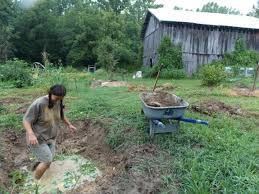Around here this is not a problem: just dig it, it’s ready. Mid Limburg (be) is also known as The Wijers or the 1000 pond area. The mining of iron bearing rocks arose naturally ponds everywhere. They were later deepened to breed fish. Also by peat stabbing arose ponds, and later by the mining of sand and gravel. Some are filled with garbage as landfill, others are used for diving, surfing, sailing, camping, swimming, fishing ... If you want to create a puddle on a penetrable layer you will have to make it impervious by bringing in clay (or bentonite and coating bottom and side walls with this. You can of course also use plastic, rubber or other synthetic work, or apply a coating of concrete or cemented masonry. But there is also a more natural way. The clay particles are so small and so close together that they do not transmit water. If you don’t have clay in the neighborhood, there is another natural method possible.
If you want to create a puddle on a penetrable layer you will have to make it impervious by bringing in clay (or bentonite and coating bottom and side walls with this. You can of course also use plastic, rubber or other synthetic work, or apply a coating of concrete or cemented masonry. But there is also a more natural way. The clay particles are so small and so close together that they do not transmit water. If you don’t have clay in the neighborhood, there is another natural method possible.
With sufficient water supply you can get every pond watertight. All leaks run and silt up after a while. On the sandy soil of Herkenrode (Hasselt, Belgium) this worked to put old ponds back into use in spite of leaks and moles. The nearby Demer ensured a permanent supply.
Even on sandy soils appear natural pools and ponds. That happens in depressions where organic material comes together and compacts, and in places where pigs, but also (water) buffalo and other animals are trampling, fattening and wallow. There are three processes that are believed to contribute to water resistance.
1 Organic material (anaerobic, without oxygen) breaks down into the smallest constituents. If you dive into a pond you usually can find twigs and leaves on the bottom. But underneath is very fine silt that at the slightest touch can float in dense clouds. To settle back then slowly, as fine dust at the bottom. Those small particles can be close enough to hold back water.
2 The anaerobic bacteria would also take care of forming a smooth, slimy and even waterproof film between the material they degrade. This biological membrane seals the bottom.
3 In animals pools would also the trampling ensure compaction, and also waterproofing. Additionally would by shaking and trembling of the ground, the larger parts (stone, gravel ..) come up, and collect the fines down. The effect that you see when you shake a box with cereals. It is also called Brazil nut effect or Granular convection.
An old Russian method mimics this effect to create ponds or dams. It is called gleying. I can recognize the word in clay in it.
Gley soils are naturally green-blue-gray by the anoxic humidity which reduce iron compounds. The land is wet and fertile, the soil poor in oxygen, hard and sticky, and slowly permeable.
To mimic this process, layers of organic material such as manure, and several layers of vegetable matter: grass, leaves are arranged on the bottom and walls in a layer of about 20 cm. The whole is then sealed from air with a layer of rammed earth. (It could also be (temporarily) a plastic film.) The anaerobic fermentation produces in 1 to 2 weeks threads of bacterial slime which can permanently seal the soil. After two weeks, the coating may be removed and the pond can be filled.
Another possibility is to enclose a low, to make the soil regularly wet and allow livestock to use this intensively. Or go kicking and kneading yourself.
In a shallow pond all live can die from severe frost. Therefore, make sure that there is a point which is at least 80 cm deep.
